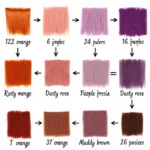Transforming your hardwood floors can dramatically enhance your home’s aesthetic. Whether you’re aiming for a modern update, a classic restoration, or a bold statement, changing your hardwood floor color is a powerful way to achieve your desired look. This guide will delve into the various methods, considerations, and expert tips to help you successfully navigate the process of changing your hardwood floor color.
Changing the color of your hardwood floors is a significant undertaking, but the results can be stunning. Let’s explore the steps involved. can you change the color of wood floors It’s a worthwhile investment that can revitalize your living space.
Assessing Your Floors and Choosing the Right Method
Before diving into the process, it’s crucial to assess the current condition of your hardwood floors. Are they solid hardwood or engineered wood? Have they been previously stained or sealed? These factors will influence the best approach for changing the color. For solid hardwood, you have more flexibility, including sanding down to bare wood. Engineered wood, with its thin veneer layer, requires more delicate handling. Identifying your floor type is the first essential step.
Sanding and Refinishing: A Classic Approach
For a complete color transformation, sanding and refinishing is the most effective method. This involves sanding down the existing finish, stain, and even some of the wood itself to create a fresh surface for the new color. This process allows for the deepest penetration of stain, resulting in a rich and lasting color.
 Sanding Hardwood Floors for Color Change
Sanding Hardwood Floors for Color Change
Staining: Adding Depth and Richness
Staining is a popular choice for adding depth and richness to hardwood floors. From light, natural tones to deep, dramatic hues, stains can create a wide range of effects. Choosing the right stain color is a crucial step, and it’s recommended to test the stain on a small, inconspicuous area of the floor before applying it to the entire surface.
Whitewashing and Pickling: Achieving a Light and Airy Look
For a lighter, more airy feel, whitewashing or pickling can be excellent choices. These techniques involve applying a white or light-colored stain to the wood, allowing some of the natural wood grain to show through. This creates a subtle, textured look that can brighten up any room.
Preparing Your Floors for the Transformation
Proper preparation is essential for a successful outcome. This includes thoroughly cleaning the floors to remove any dirt, dust, or debris. If your floors have a glossy finish, you’ll need to lightly sand them to create a surface that the new stain can adhere to.
Applying the New Color: Step-by-Step Guide
- Sanding (if necessary): Sand the floors using a drum sander or orbital sander, starting with a coarse grit and gradually moving to finer grits.
- Cleaning: Thoroughly vacuum and tack cloth the floors to remove all dust.
- Staining (optional): Apply the stain evenly using a brush, rag, or applicator pad, following the manufacturer’s instructions.
- Sealing: Apply a sealant to protect the newly stained floors and enhance their durability.
Maintaining Your Newly Colored Hardwood Floors
Once your hardwood floors have been transformed, proper maintenance is key to preserving their beauty. Regular sweeping or vacuuming, along with occasional mopping with a hardwood floor cleaner, will keep them looking their best. can stairs be a different color than floor Considering the overall aesthetic of your home is crucial.
“Choosing the right finish is just as important as choosing the right color. A durable finish will protect your floors from scratches, spills, and wear and tear,” says John Miller, a seasoned flooring expert with over 20 years of experience.
Conclusion
Changing your hardwood floor color can revitalize your home and create a dramatic shift in its ambiance. By carefully considering your options, preparing your floors thoroughly, and following the proper application techniques, you can achieve stunning results that will last for years to come. Remember that changing your hardwood floor color is a transformative process. can you change the color of vinyl plank flooring Different flooring materials require different approaches.
FAQ
- Can I change the color of engineered hardwood floors? Yes, but with limitations due to the thin veneer.
- How long does it take to change hardwood floor color? It depends on the method, but typically 2-5 days.
- What is the best way to remove old stain from hardwood floors? Sanding is the most effective method.
- How often should I refinish my hardwood floors? Every 7-10 years, depending on wear and tear.
- Can I do it myself, or should I hire a professional? While DIY is possible, professionals ensure a flawless finish.
- What is the cost of changing hardwood floor color? It varies depending on the method, size of the area, and labor costs.
- How do I choose the right stain color for my hardwood floors? Consider your existing decor and personal preferences. what color is stone gray Understanding color palettes can greatly assist in making the right choice.
“Remember to test your stain color on a hidden area before applying it to the entire floor. This will help you avoid any unpleasant surprises and ensure you achieve the desired look,” advises Maria Sanchez, a renowned interior designer known for her innovative use of color. how to get hair back to natural color Color transformations can be tricky, so careful planning is always recommended.
When you need assistance, contact us at Phone Number: 0373298888, Email: [email protected], or visit our address: 86 Cau Giay, Hanoi. We have a 24/7 customer service team.
